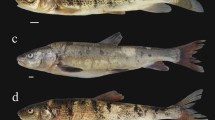Abstract
The diets ofPolycelis nigra, P. tenuis, Dugesia polychroa, Dendrocoelum lacteum, Glossiphonia complanata, Helobdella stagnalis andErpobdella octoculata in an English lake were examined, using a serological technique, and compared between 1981–82 and 1989–90. Leech, triclad and prey abundances were also recorded. Between the two studies, snail numbers crashed whereas the abundances ofAsellus andGammarus increased.Dugesia andGlossiphonia numbers decreased substantially, whilstPolycelis tenuis andHelobdella abundances increased. In the second study, the snail component in the diet was greatly reduced resulting in a broader food niche, particularly forDugesia andGlossiphonia, and greater food overlap between the predators with the exception ofDendrocoelum andErpobdella which do not eat molluscs. It is postulated that the reduced size of the snail refuge, and consequent increase in severity of interspecific competition with other predators, particularlyPolycelis andHelobdella, led to the observed decrease in abundances ofDugesia andGlossiphonia. The decline in the last two genera, perhaps coupled with increased crustacean abundance, could have contributed to the numerical increase of the competitively superiorPolycelis tenuis andHelobdella.
Similar content being viewed by others
References
Hurlbert, S. H., 1978. The measurement of niche overlap and some relatives. Ecology 59: 67–77.
Martin, A. J., R. M. H. Seaby & J. O. Young, in press. Food limitation in lake-dwelling leeches: field experiments. J. anim. Ecol.
Pickavance, J. R., 1970. A new approach to the immunological analysis of invertebrate diets. J. anim. Ecol. 39: 715–724.
Pielou, E. C., 1975. Ecological Diversity. J. Wiley & Sons, New York.
Reynolds, C. S., 1979. The limnology of the eutrophic meres of the Shropshire-Cheshire plain. Fld Stud. 5: 93–173.
Reynoldson, T. B., 1966. The distribution and abundance of lake-dwelling triclads — towards a hypothesis. Adv. Ecol. Res. 3: 1–71.
Reynoldson, T. B., 1983. The population biology of Turbellaria with special reference to the freshwater triclads of the British Isles. Adv. Ecol. Res. 13: 235–326.
Reynoldson, T. B. & R. W. Davies, 1970. Food niche and co-existence in lake-dwelling triclads. J. anim. Ecol. 39: 599–617.
Reynoldson, T. B., J. F. Gilliam & R. M. Jacques, 1981. Competitive exclusion and co-existence in natural populations ofPolycelis nigra andP. tenuis (Tricladida, Turbellaria). Arch. Hydrobiol. 92: 71–113.
Schoener, T. W., 1970. Nonsynchronous spatial overlap of lizards in patchy habitats. Ecology 51: 408–418.
Shannon, C. E. & W. Weaver, 1963. The Mathematical Theory of Communication. McGraw-Hill Book Co., New York.
Spelling, S. M. & J. O. Young, 1987. Predation on lake-dwelling leeches (Annelida; Hirudinea): an evaluation by field experiment. J. anim. Ecol. 56: 131–146.
Young, J. O., 1980. A serological investigation of the diet ofHelobdella stagnalis (Hirudinea: Glossophoniidae) in British lakes. J. Zool., Lond. 192: 467–488.
Young, J. O., 1981. A comparative study of the food niches of lake-dwelling triclads and leeches. Develop. Hydrobiol. 6: 91–102.
Young, J. O., A. J. Martin & R. M. H. Seaby, 1993. Competitive interactions between the lake-dwelling leechesGlossiphonia complanata (L.) andHelobdella stagnalis (L.): an experimental investigation of the significance of a food refuge. Oecologia 93: 156–162.
Young, J. O. & S. M. Spelling, 1986. The incidence of predation on lake-dwelling leeches. Freshwat. Biol. 16: 465–477.
Young, J. O. & S. M. Spelling, 1989. Food utilization and niche overlap in three species of lake-dwelling leeches (Hirudinea). J. Zool., Lond. 219: 231–243.
Author information
Authors and Affiliations
Rights and permissions
About this article
Cite this article
Martin, A.J., Seaby, R.M.H. & Young, J.O. The consequence of a food refuge collapse on a guild of lake-dwelling triclads and leeches. Hydrobiologia 277, 187–195 (1994). https://doi.org/10.1007/BF00007300
Received:
Revised:
Accepted:
Issue Date:
DOI: https://doi.org/10.1007/BF00007300




